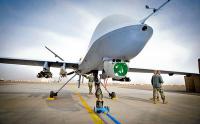-
Robots to pull wounded soldiers off battlefield

Most Americans have seen at least one war movie, where at some point a fresh-faced young private is hit with some shrapnel. From the ground, he calls out for the unit medic — another young guy, from another small town, whose quick reaction and skill just may save his life. In the near future, however, it may no longer be another soldier, who comes running to his side. Instead, it might be an Army-operated unmanned aerial or ground vehicle.
-
-
Beyond data theft: Next phase of cyber intrusions will include destruction, manipulation of data
James Clapper, director of U.S. intelligence, and other senior intelligence officers, have warned Congress that the next phase of escalating online data theft will likely involve the manipulation of digital information. Clapper on Wednesday told lawmakers on the House Intelligence Committee that a “cyber Armageddon,” in which a digitally triggered damage to physical infrastructure results in a series of catastrophic events, is less likely than “cyber operations that will change or manipulate data.” Leaders of the U.S. intelligence community told lawmakers that the manipulation or destruction of data would undermine confidence in data stored on or accessible through U.S. networks, engendering an uncertainty which could jeopardize U.S. military situational awareness and undermine business activity.
-
-
UN inquiry to determine who is responsible for chemical attacks in Syria
Russia has withdrawn its objections to a UN investigation into identifying the culprits responsible for chemical attacks in Syria, allowing a probe to begin, UN diplomats said Thursday. For the last two years, Russia had insisted that a series of UN investigative teams sent to Syria would be limited to finding out whether or not chemical weapons had been used, but would be barred from identifying who was responsible for launching them.
-
-
Russian-American admits to smuggling sensitive weapon tech to Russia
Alexander Fishenko, 49, a Russian-American businessman, pleaded guilty yesterday (Wednesday) to charges of smuggling sensitive U.S. microelectronics to Russia. He was arrested in 2012 on allegations that he had shipped export-controlled electronics and computer chips which are used in radar and surveillance systems, missile guidance systems, and detonation triggers.
-
-
Engineers design invisibility cloak for military drones
Inspired by the well-known Invisibility Cloak from Harry Potter, electrical engineers have created a new design for their cloaking device, using a Teflon substrate, studded with cylinders of ceramic, which is thinner than any prior development and does not alter the brightness of light around concealed objects. The Teflon has a low refractive index, while the ceramic’s refractive index is higher, which allows light to be dispersed through the sheet without any absorption. Compared to an invisibility cloak, this technology has not only the ability to conceal, but the ability to increase optical communication signal speed and to collect solar energy.
-
-
Data show drone attacks doomed to fail against ISIS in Syria

This week, the Washington Post published a story about a new U.S. plan to use lethal drone strikes in Syria to destroy ISIS capabilities on the ground. The desire to do something — anything — to destroy the capabilities of a group so luridly destructive is understandable, but our haste to show results will likely result in a hollow victory at best. But there is a problem: there’s no evidence that drone strikes work. On the contrary, ample evidence shows drone strikes have not made Americans safer or reduced the overall level of terrorist capability. The strikes amount to little more than a waste of life, political capital, and resources. Drones cannot deliver victory over ISIS, but in any event, lacking a cohesive, articulate political strategy for governance and post-ISIS reconstruction, no military solution can produce the results we’re looking for. Lacking the political strategy, more of the same in Syria promises no better.
-
-
How Western Europe came to dominate the globe

Although Europe represents only about 8 percent of the planet’s landmass, from 1492 to 1914, Europeans conquered or colonized more than 80 percent of the entire world. There are many possible explanations for why history played out this way, but few can explain why the West was so powerful for so long. Caltech’s Philip Hoffman, a professor of business economics and history, has a new explanation: the advancement of gunpowder technology. The Chinese invented gunpowder, but Hoffman argues that certain political and economic circumstances allowed the Europeans to advance gunpowder technology at an unprecedented rate — allowing a relatively small number of people quickly to take over much of the rest of the globe. What lessons does his explanation of the West’s rise to dominance offer for today’s policy makers? “In a world where there are hostile powers, we really don’t want to get rid of spending on improving military technology,” Hoffman says. “I would much rather see expenditures devoted to infrastructure, or scientific research, or free preschool for everybody – things that would carry big economic benefits,” and “I wish we did live in that world, but unfortunately it’s not realistic.”
-
-
U.S. Navy champions unmanned systems over, on, and under the sea
The presence of unmanned systems in the maritime military domain is growing, and the U.S. Navy has decided to make several organizational, and conceptual, changes in order to deal with unmanned systems in a more holistic fashion. Rear Adm. Robert P. Girrier has been named the Navy’s first director of unmanned weapon systems, and Secretary of the Navy Ray Mabus announced in April that he would appoint a new Deputy Assistant Secretary of the Navy for Unmanned Systems, “so that all aspects of unmanned — in all domains — over, on and under the sea and coming from the sea to operate on land — will be coordinated and championed.”
-
-
Counter-drone technologies demonstrated at DoD’s Black Dart event
Small, unmanned aircraft systems (UASs, aka UAVs, for unmanned aerial vehicle), or drones, are easy to obtain and launch and they are hard to detect on radar, making them of particular concern to law enforcement and the Department of Defense. Earlier this month DHS circulated an intelligence assessment to police agencies across the United States warning about drones being used as weapons in an attack. DOD says that Black Dart 2015, which began 26 July and ran through 7 August, is the Department of Defense’s largest live-fly, live-fire joint counter-UAS technology demonstration. One of the innovative developers of counter-UAS technologies is SRC Inc., a not-for-profit company formerly affiliated with Syracuse University. The company showed its SR Hawk surveillance radar, which is integral to its layered approach to defending against UASs.
-
-
Reversal: UN now calls for identifying perpetrators of chemical attacks in Syria

The UN Security Council on Friday has unanimously adopted a resolution calling for identifying those using chlorine and other chemical weapons in attacks in Syria. Friday’s resolution is a reversal of Russia’s position, and another indication that Russia is distancing itself from Assad. In 2013, when the Security Council passed the resolution authorizing the removal of chemical weapons from Syria, Russia – which, with Iran, is Assad’s main supporter – conditioned its support for the resolution on adding to it a clause which would explicitly prohibit Organization for the Prohibition of Chemical Weapons (OPCW) or the UN from determining who is responsible for chemical attacks in Syria, if such attacks continue. The Friday resolution fills a gap in attributing blame for chemical weapons attacks, allowing for the perpetrators of such attacks to be brought to justice.
-
-
U.K. conducted chemical weapons experiments on “unconsenting participants”
In 1963 the U.K. Ministry of Defense’s Porton Down military science center carried out the first of a series of tests to release zinc cadmium sulphide in the atmosphere over Norwich. It was one of many examples of secret experiments conducted in the name of military research during the 1950s and 1960s, now chronicled for the first time in a new book. The book provides a comprehensive overview of state military scientific research on chemical and biological weapons by Britain, the United States, and Canada since the First World War. Between 1946 and 1976, “Britain was turned into a large-scale open-air laboratory; her people into an army of unconsenting participants,” the author writes.
-
-
Pentagon: Climate change aggravates U.S. security risks
Global climate change will aggravate problems such as poverty, social tensions, environmental degradation, ineffectual leadership, and weak political institutions that threaten stability in a number of countries, according to a report the Defense Department sent to Congress last week. The report finds that climate change is a security risk, Pentagon officials said, because it degrades living conditions, human security, and the ability of governments to meet the basic needs of their populations.
-
-
Students race robot submarines in RoboSub competition
High school and college engineering students from across the globe competed for bragging rights and cash prizes at the 18th International RoboSub Competition, which wrapped up 26 July. The mission theme for this year’s contest played on the theme of the “Back to the Future,” movie trilogy. The individual autonomous underwater vehicle (AUV) had to navigate and complete an obstacle course — with tasks like “check the flux capacitor” and “travel through the time portal” — without human or computer interaction by team members.
-
-
More evidence emerges of ISIS’s use of chemical weapons
A joint investigation by two independent organizations has found that ISIS has begun to use weapons filled with chemicals against Kurdish forces and civilians in both Iraq and Syria. ISIS is notorious for its skill in creating and adapting weapons and experts are concerned with the group’s access to chemical agents and its experiments with and the use of these agents as weapons.
-
-
North Korea conducted human experiments with chemical weapons: Defector
A 47-year old North Korean researcher has defected to Finland, taking with him gigabytes of information on human experiments which he plans to present to EU parliament later this month. The scientist, using the pseudonym “Lee,” worked at a microbiology research center in Ganggye, Chagang Province, which shares a border with China. Lee reached Finland via the Philippines, according to a Korean human rights group.
-
More headlines
The long view
Bookshelf: Smartphones Shape War in Hyperconnected World
The smartphone is helping to shape the conduct and representation of contemporary war. A new book argues that as an operative device, the smartphone is now “being used as a central weapon of war.”
